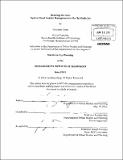Drawing the line : spatial street vendor management in Ho Chi Minh City
Author(s)
Sung, Courtney (Courtney A.)
DownloadFull printable version (7.150Mb)
Alternative title
Spatial street vendor management in Ho Chi Minh City
Other Contributors
Massachusetts Institute of Technology. Dept. of Urban Studies and Planning.
Advisor
Annette Kim.
Terms of use
Metadata
Show full item recordAbstract
A lack of consensus exists among urban planners and government officials on what to do with the complex issue of informal street vending and sidewalk usage, with cities often turning to ineffective licensing or harmful street clearance. This paper seeks to address this unfulfilling dichotomy by analyzing a tourism proposal for a painted pedestrian path in Ho Chi Minh City, Vietnam, to assess whether this intervention has potential as a spatial management tool for street vendors, given existing sidewalk practices. Since Ho Chi Minh City has taken to clearing vendors in the name of tourism, this proposal uniquely positions itself at the nexus of street vendor management and urban tourism, and hopes to capitalize on two existing forms of management in the city: a painted sidewalk line to regulate vending, and an informal motorcycle taxi union. To understand the existing system of sidewalk uses, this thesis analyzes official reports and policies, utilizes interviewing and mapping fieldwork conducted in Ho Chi Minh City with street vendors, and examines data from news articles and tourist surveys. These three levels of research reveal significant mismatches in policy goals and existing practices, such as the government's targeting mobile street vendors when they take up significantly less space than business spillover and sidewalk cafes, and the government's attitude of clearing the streets for tourists when in fact tourists comment on Vietnamese street life and street food more than any other experience. Given these mismatches, it seems that this visual line has potential to both include street vendors and organize sidewalk life into an appealing tourist experience. However, the goal or purpose of the intervention will ultimately determine its impacts on the city with respects to displacement and gentrification. Through identifying the strengths and weaknesses of each approach, this thesis is able to propose strategies and planning tools to mitigate the impacts of this intervention, and argues that a visual tourist intervention of this nature could in fact present a viable street vendor management model.
Description
Thesis (M.C.P.)--Massachusetts Institute of Technology, Dept. of Urban Studies and Planning, 2011. Cataloged from PDF version of thesis. Includes bibliographical references (p. 87-92).
Date issued
2011Department
Massachusetts Institute of Technology. Department of Urban Studies and PlanningPublisher
Massachusetts Institute of Technology
Keywords
Urban Studies and Planning.